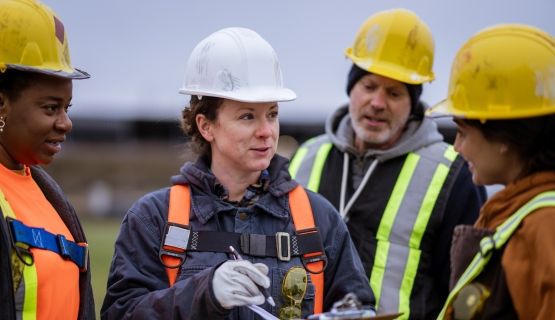Illness/injury prevention
IWH has a long history of conducting research to provide practical guidance to employers, workers, OHS professionals and regulators about what works and what doesn’t in injury or illness prevention. This research targets the injury and illness prevention practices of workplaces, as well as the programs developed by governments, health and safety associations and others to support and motivate workplaces to adopt effective practices.
Featured

At Work article
Differences in firm-level AI use for health and safety
To what extent are Canadian workplaces using artificial intelligence (AI) to help support workers’ health and safety? And what do these workplaces have in common? An IWH study surveyed firms across Ontario and British Columbia to find out.
Published: October 8, 2025

Impact case study
Saskatchewan’s construction safety group uses IWH tool to improve safety culture
This case study details how the Saskatchewan Construction Safety Association (SCSA) members have been analyzing IWH-OPM scores to adjust their safety practices and how SCSA has been using the data to tailor their outreach.
Published: February 10, 2025

Impact case study
MOL broadens strategy for identifying poor OHS performers
IWH evaluation of high risk firm program confirms need for a redesign.
Published: April 2014

Impact case study
WCB adapts toolkit for newcomers to Manitoba context
The toolkit, called Prevention is the Best Medicine, hopes to bridge the knowledge gap among newcomers of OHS and workers' compensation issues.
Published: April 2014
At Work article
At Work article
Non-academic OHS sources enrich systematic reviews
IWH review team also finds workload a challenge when including grey literature in systematic reviews
Published: February 2014

Tools and guides
Breakthrough Change in OHS: Case study series
Each of four case studies tells the story of an Ontario organization that achieved firm-level, sustained improvement in health and safety performance. Each illustrates the factors critical to making large improvement in health and safety, based upon an evidence-based model of breakthrough change developed through Institute for Work & Health research.
Published: January 2014
Project
Project
Synthesizing and tailoring OHS knowledge for use in specific provincial and local contexts
In partnership with Memorial University’s SafetyNet Centre for Occupational safety & Health Research and the Workers Compensation Board of Manitoba, IWH developed and tested an innovative methodology for synthesizing current scientific workplace health, safety and disability prevention knowledge and tailoring it for use in specific provincial and local contexts.
Status: Completed 2017

Impact case study
CAMH improves office ergonomics through IWH online training program
A piloted training program was so successful it's now offered to all staff at this hospital and research centre.
Published: November 2013

Issue Briefing
Developing leading indicators of work injury and illness
Leading indicators have the potential to help identify factors affecting the risk of injury, allowing workplaces to address these factors before injuries occur. This Issue Briefing looks at efforts to date to identify OHS leading indicators and the challenges involved.
Published: October 2013
At Work article
At Work article
New Brunswick’s WorkSafeNB adopts IWH’s safety culture yardstick
Institute of Work & Health’s Organizational Performance Metric chosen after study shows firms’ scores on eight-item questionnaire correlate with claims rates
Published: July 2013
Project report
Project report
Assessment of the utility of WorkSafeNB's Internal Responsibility System Questionnaire and IWH's Organizational Performance Metric: public report
In 2010, WorkSafeNB asked the Institute for Work and Health (IWH) to assess its Internal Responsibility System Questionnaire (IRSQ), a survey tool it had developed to measure safety culture within an organization. As part of its assessment, IWH compared the IRSQ with another previously validated tool designed to measure leading indicators, called the IWH Organizational Performance Metric (IWH-OPM). This document reports on the assessment of these two tools.
Published: July 2013
Journal article
Journal article
Response to Weinstock and Slatin's (2012) critique of IWH-NIOSH systematic review of the effectiveness of OSH training
Published: New Solutions, January 2013